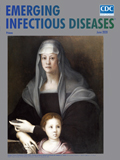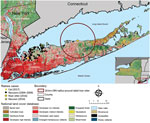
Volume 26, Number 6—June 2020
Dispatch
Origin of 3 Rabid Terrestrial Animals in Raccoon Rabies Virus–Free Zone, Long Island, New York, USA, 2016–2017
On This Page
Tables
Downloads
Article Metrics
Scott Brunt , Heather Solomon, Hilaire Leavitt, Erica Lasek-Nesselquist, Pascal LaPierre, Matt Shudt, Laura Bigler, Navjot Singh, and April D. Davis
, Heather Solomon, Hilaire Leavitt, Erica Lasek-Nesselquist, Pascal LaPierre, Matt Shudt, Laura Bigler, Navjot Singh, and April D. Davis
Abstract
During 2016–2017, three rabid terrestrial animals were discovered in the raccoon rabies virus–free zone of Long Island, New York, USA. Whole-genome sequencing and phylogenetic analyses revealed the likely origins of the viruses, enabling the rabies outbreak response (often costly and time-consuming) to be done less expensively and more efficiently.
Rabies has been endemic to the eastern United States in raccoons (Procyon lotor) since 1960 and endemic to New York, USA, since the 1990s (1). The spread of rabies virus from raccoons in the mid-Atlantic states to species in New York has been reconstructed with spatiogenetic and phylogenic analyses (2). Despite this spread, a few locations in the region, including Suffolk and Nassau Counties on Long Island, New York, have been considered to be rabies free since 2011 (3). Maintaining these areas as low risk for rabies substantially decreases the likelihood of human and animal exposure to rabies virus and dramatically reduces the expenses paid for postexposure rabies virus treatments and rabies control (4).
To identify any breaches in the elimination zone, Nassau and Suffolk County health departments, veterinarians, and wildlife control officers routinely submit animals with clinical signs compatible with rabies for rabies virus testing to the New York State Department of Health Rabies Laboratory (Slingerlands, New York, USA). Before 2016, rabies had not been reported in Suffolk County since 2009 or in Nassau County since 2007 (Figure 1) (5). During 2016–2017, rabies reappeared in Nassau and Suffolk Counties in 3 terrestrial animals: a raccoon (Procyon lotor), a river otter (Lontra canadensis), and a domestic cat (Felis catus). Here, we describe our efforts to identify the origins of these rabid animals and our contingency plans to eliminate further cases and restore the rabies virus–free zone status.























.png)











No hay comentarios:
Publicar un comentario